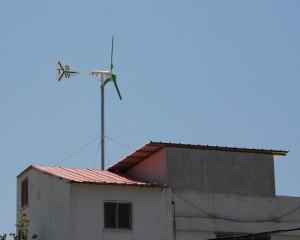 Though you probably have seen or heard about giant utility-sized wind farms that contribute to powering thousands of homes, much smaller, residential turbines are also popping up around the country. In the past year, wind turbine sales in the U.S. and Britain have increased by 26 and 65 percent, respectively, despite their exclusive price tag. However, if the industry is to survive, let alone flourish, manufacturers must address several key issues. Below are three problems facing the industry that were highlighted in the October 2011 edition of Consumer Reports.
Though you probably have seen or heard about giant utility-sized wind farms that contribute to powering thousands of homes, much smaller, residential turbines are also popping up around the country. In the past year, wind turbine sales in the U.S. and Britain have increased by 26 and 65 percent, respectively, despite their exclusive price tag. However, if the industry is to survive, let alone flourish, manufacturers must address several key issues. Below are three problems facing the industry that were highlighted in the October 2011 edition of Consumer Reports.
1. Quality Control: Even though sales of residential turbines outpaced the overall industry by 9 percent, analysts are concerned that under-performing products and product defects may dampen long-term growth. In its review of the new Honeywell WT6500 Wind Turbine built by WindTronics, Consumer Reports found that it produced just a “fraction” of the energy claimed by the manufacturer’s online calculator for their location in New York. In fact, they said at the observed rate of energy production, the return on investment (ROI) would actually exceed the turbine’s 20-year life expectancy. Another area of concern is product defects. Proven Energy, one of the largest producers of small turbines, told customers to put the brakes on their turbines after the company became aware of a “potential manufacturing defect” in a significant number of turbine shafts. To address these issues, a voluntary certification program is being developed by the American Wind Energy Association, which should be functional in six to twelve months.
2. Accuracy of Predicted Energy Output: Even though the $11,000, roof-mounted Honeywell WT6500 turbine tested by Consumer Reports produced the expected wattage at controlled wind speeds, it produced only a fraction of the energy the manufacturer said they should expect in the real world. Much of the problem resulted from WindTronics’ online calculator which gives wind speed estimates by zip code, but at an altitude of 164 feet (rather than a normal rooftop height of at least 33 feet). Even with estimates at lower elevations, however, power output will probably prove difficult to predict since site-specific attributes like trees, hills, or nearby houses will disrupt airflow. After having the Honeywell TW6500 installed, Consumer Reports was later informed that their site was unsuitable for a wind turbine. To get around this problem, they recommend that customers get a site analysis before shoveling out thousands of dollars.
3. Cost: Since cost and ROI are, by far, the biggest reasons for and against “green” home improvements, manufacturers must reduce costs if the industry is to survive without the current 30 percent unlimited federal-tax credit (set to expire in 2016). While the small turbine sector saw impressive gains last year, it would be foolish to think tax credits didn’t play a significant role in propping up sales. In the future, it will be interesting to see whether the wind industry will be buttressed by corporations like Google, which have helped homeowners secure financing for solar arrays.

